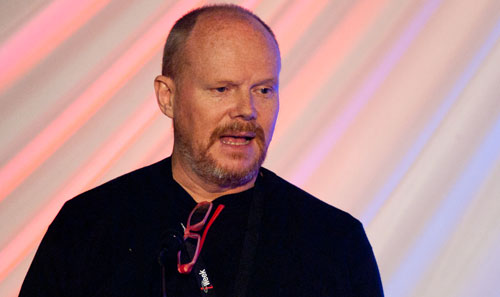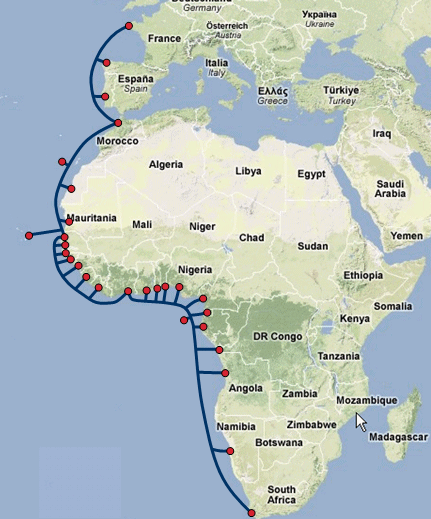
State-owned Sentech will use its telecommunications licence to land a new, high-capacity international cable system in SA.
A consortium comprising 25 investors, led by France Telecom/Orange, will pay for the construction of the 14 000km system, known as the Africa Coast to Europe (Ace) cable.
The Ace system will have a design capacity of 1,9Tbit/s and is expected to be ready for service sometime in 2011. It will run along Africa’s west coast.
Ace is one of three new cables that are planned for the continent’s west coast — together, the new systems promise to deliver a surplus of bandwidth in a part of the world where bandwidth has been scarce and expensive.
The Ace cable will supplement the planned 5,1Tbit/s, SA-led West African Cable System (Wacs) and the 1,9Tbit/s Main One, led by Nigerian investors — the first leg of Main One will connect Europe with Nigeria; the second leg will extend to Cape Town.
Wacs is expected to be ready for service in early 2011; Ace and the second leg of Main One should be ready soon thereafter.
Sentech has agreed to land the Ace cable in SA on behalf of the operator-led consortium. The cable will run from Cape Town in SA to Penmarc’h in north-west France.
The news follows a decision by the cable consortium to sign a memorandum of understanding with the Baharicom Development Company (BDC).
BDC, created by the African government-led New Partnership for Africa’s Development (Nepad), is charged with co-ordinating the construction Uhurunet, the submarine segment of a planned continent-wide Nepad network.
Nepad is pushing ahead with the project in spite of the range of private-sector-led undersea cable plans.
The Nepad initiative enjoyed strong backing from former communications director-general Lyndall Shope-Mafole, who quit the department last year, soon after resigning from the ruling ANC party to defect to the Congress of the People. Shope-Mafole is romantically involved with Nepad e-Africa Commission deputy chairman Henry Chasia.
New communications director-general Mamodupi Mohlala has not yet outlined her department’s views of the Nepad-led initiative or what role she expects Sentech to play in telecoms.
Nepad had hoped to work with the consortium of telecoms operators building the East Africa Submarine System (Eassy) on Africa’s east coast, but the parties fell out over who should run the system and how it should be regulated. Eassy is expected to be ready for service in mid-2010.
According to a press release on Nepad’s website, the collaboration between the Ace consortium and BDC “means that the cable will now be extended all the way to SA, and will ensure that every country on the West African coast is connected to the cable”.
Originally, Ace’s backers had only planned to extend the cable from France to Gabon.
Nepad says BDC has a “landing party agreement” with Sentech, which will allow the Ace cable to land on SA shores. It’s not known how much Sentech will invest in the project, if anything.
Meanwhile, Nepad says BDC “is continuing negotiations with several submarine cable developers to realise the Uhurunet segment along the east coast of Africa. Similar negotiations are ongoing for the North African segment.”
The African body says the objective of its IT infrastructure programme is to “ensure that every country in Africa is connected to its neighbours by a broadband network and, in turn, to the rest of the world through existing or planned submarine cable systems.
“To this end, the Nepad e-Africa Commission is promoting the development of the Nepad ICT Broadband Infrastructure Network, which consists of a submarine segment, Uhurunet, and a terrestrial network, Umojanet.”
But Steve Song, telecoms fellow at the Shuttleworth Foundation, says that with all the private-sector investment in submarine cables, there is no need for Nepad to be involved.
Song, who has developed a detailed map showing existing and planned cable systems affecting Africa, says it is evident that there is sufficient private-sector interest in building new infrastructure.
“Of course, that wasn’t necessarily true when Uhurunet was conceived, and hindsight is always crystal clear,” Song says. That said, “multi-government political partnerships don’t make for great business management vehicles”.
On the number of cables that are due to land in SA in the next two years, Song says there will initially be too much capacity coming into the country — and on to the continent. “However, undersea cable investors are betting that demand in Africa will grow non-linearly,” he says. “I am inclined to agree with them.”
Song says there are 1bn people in Africa, with only a trickle of international bandwidth serving them at present. “I think that within five years there will be sufficient demand to sustain these cables.” — Duncan McLeod, TechCentral


